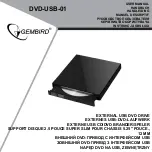
VFD68 Variable Frequency Drive (575 VAC) Installation Instructions
21
VFD68Dxx Drive Parameters
You can use the default parameter setting with the P499RxP-107C Transducer and R410a refrigerant within a
range of operation that depends on the specific model of P499 Transducer selected. All other applications require
some parameter changes and may require different transducers.
PU
Lit to indicate the PU operation mode
EXT
Lit to indicate the external operation mode
Table 16: Parameter Descriptions for VFD68Dxx Drives (Part 1 of 2)
Parameter
Indication
on Monitor
Description
Settings
Default
Setting
P. 0
Torque Boost:
Defines the voltage (% total V) applied to the
motor when the drive starts the motor at 0 Hz.
0–30%
4% or 3%
P. 1
Maximum Frequency:
Defines the maximum speed of the
motor in your application. See Figure 14.
0–120 Hz
60 Hz
P. 2
Minimum Frequency:
Defines the minimum speed of the
motor in your application.
1
See
0–120 Hz
12.5 Hz
P. 3
Base Frequency:
Set parameter to the rated frequency [Hz]
on motor rating plate.
0–400 Hz
60 Hz
P. 7
Acceleration Time:
Defines the time required to accelerate
from stop (0 Hz) to full rated RPM (60 Hz).
0–3600 seconds
15 seconds
P. 8
Deceleration Time:
Defines the time required to decelerate
from full rated RPM (60 Hz) to stop (0 Hz).
0–3600 seconds
15 seconds
P. 9
Motor Rated Current:
Set parameter to the rated FLA on
motor rating plate.
0–500 A
Rated VFD68
Output
P. 19
VFD Output Voltage:
Defines the maximum output voltage
relative to the drive supply voltage.
2
•
9999: the maximum output voltage is the same as the
drive power supply voltage
0–1000V, 9999
9999
P. 22
Stall Prevention Output Current Level:
Defines the current
level (as a % of motor FLA) at which the drive begins to
adjust the output frequency (Hz) to reduce the output current.
0–200%
150%
P. 31
Frequency Jump 1A:
Frequency Jump parameters (P. 31
and P. 32) are used to set the low speed behavior of the
drive. This parameter typically remains at 0 Hz
0–400 Hz, 9999
0 Hz
P. 32
Frequency Jump 1B:
Maximum frequency to skip over to
avoid very low fan airflow and unnecessary motor
overheating. (9999: frequency jump not enabled)
Note:
Ensure that this is set equal to
P.902
(screen a) and
P.904
(screen a).
0–400 Hz, 9999
12.5 Hz
P. 33
Frequency Jump 2A:
To avoid resonance noise caused by
natural frequency of mechanical system, enter frequency just
below
noisy frequency 2.
0 to 400 Hz, 9999
9999
P. 34
Frequency Jump 2B:
To avoid resonance noise caused by
natural frequency of mechanical system, enter frequency just
above
noisy frequency 2.
0 to 400 Hz, 9999
9999
P. 35
Frequency Jump 3A:
To avoid resonance noise caused by
natural frequency of mechanical system, enter frequency just
below
noisy frequency 3.
0 to 400 Hz, 9999
9999
Table 15: Unit Indications and Operating Status Indications (Part 2 of 2)
Indication
Description










































